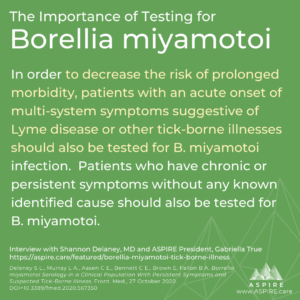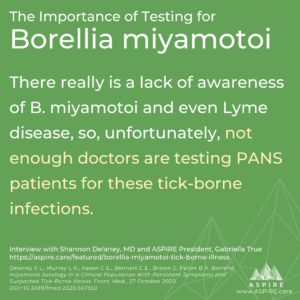ASPIRE talks with Shannon L. Delaney, MD, on the latest study of Borellia miyamotoi in those with persistent symptoms and suspected tick-borne illness
 Gabriella, ASPIRE President, sits down with Shannon L. Delaney, MD, to discuss the most recent findings on Borellia miyamotoi in those with persistent symptoms of suspected tick-borne illness. Dr. Delaney is the Director, Child and Adolescent Evaluation, Lyme & Tick-borne Disease Research Center at Columbia University and a member of the ASPIRE Professional Advisory Board member. Thank you to Kathy Rubel, ASPIRE Content Committee, for helping on this project too.
Gabriella, ASPIRE President, sits down with Shannon L. Delaney, MD, to discuss the most recent findings on Borellia miyamotoi in those with persistent symptoms of suspected tick-borne illness. Dr. Delaney is the Director, Child and Adolescent Evaluation, Lyme & Tick-borne Disease Research Center at Columbia University and a member of the ASPIRE Professional Advisory Board member. Thank you to Kathy Rubel, ASPIRE Content Committee, for helping on this project too.
Study: Delaney Shannon L., Murray Lilly A., Aasen Claire E., Bennett Clair E., Brown Ellen, Fallon Brian A. Borrelia miyamotoi Serology in a Clinical Population With Persistent Symptoms and Suspected Tick-Borne Illness. Front. Med., 27 October 2020. DOI=10.3389/fmed.2020.567350
Gabriella: Thank you for sitting down with us today to discuss your recently published study on Borellia miyamotoi. This study is the first to investigate whether patients with chronic symptoms seeking consultation for suspected tick-borne illness show evidence of prior exposure to B. miyamotoi.
Let’s start with some basics. Borrelia miyamotoi is an under-known bacteria that causes tick-borne illness. In your study, you said that 98% of the patients had never had B. miyamotoi testing. This high number indicates that it is extremely rare for a doctor to order a tick-borne illness test. Ultimately, more doctors need to learn about this tick-borne illness, and order tests more readily, and treat accordingly.
Shannon: B. miyamotoi is a type of spiral-shaped bacteria. It was first identified in 1995 in ticks from Japan. The first human cases were reported in Russia in 2011 and the Northeastern United States in 2013. So, it is relatively newly identified
B. miyamotoi is known to cause Tick-Borne Relapsing Fever (TBRF). Our study shows that the early symptoms of B. miyamotoi are very similar to symptoms of Lyme disease with fever and flu-like illness. Based on our findings, the persistent symptoms of B. miyamotoi are basically indistinguishable from Lyme disease.
 The other important note is that with tick-borne illnesses in general, Lyme, Bartonella, Borrelia miyamotoi, or some of the more rare ones, the early symptoms are often fairly subtle. There is a lot of individual variation; some are really sick and can have a significant fever for a few days, but early symptoms in other people can go undetected rather later-stage symptoms are seen further down the road. Some of the people diagnosed down the road never had the early onset severe tell-tale tick-borne illness symptoms; they present with symptoms later on in the disease course.
The other important note is that with tick-borne illnesses in general, Lyme, Bartonella, Borrelia miyamotoi, or some of the more rare ones, the early symptoms are often fairly subtle. There is a lot of individual variation; some are really sick and can have a significant fever for a few days, but early symptoms in other people can go undetected rather later-stage symptoms are seen further down the road. Some of the people diagnosed down the road never had the early onset severe tell-tale tick-borne illness symptoms; they present with symptoms later on in the disease course.
Gabriella: Were all the subjects you studied patients in your second opinion Lyme consult practice? What percentage of those patients were positive for B. miyamotoi?
Shannon: We consecutively tested patients in our second opinion consult practice for B. miyamotoi over the course of a year and a half.
- Of those 82 patients we tested, twenty-one patients (26%) were positive for the miyamotoi antibody.
- Of those that tested positive (26%), all were IgG positive and IgM negative. This is a novel finding and higher than the seropositivity rates of 3–21% previously reported in the literature.
- Of these twenty-one patients who tested positive for miyamotoi antibodies, five also met CDC surveillance criteria for definite or probable Lyme disease.
- Of the 61 patients who tested negative for B. miyamotoi, 22 met the criteria for definite or probable Lyme disease.
- The remaining 39 patients tested negative for both B. miyamotoi and B. burgdorferi antibodies.
Gabriella: Please tell us a little bit more about the test itself. What kind of test/s you used, which lab did the testing, and is it available for any doctor to order?
Shannon: For this study, we looked at antibodies to B. miyamotoi. The lab we used in the study was Imugen, which was a tick-borne specialty lab that Quest Diagnostics recently acquired. Now you can get the test through Quest. I don’t know of any other lab doing this testing for TBRF, specifically B. miyamotoi other than Igenix. Their test is a little different; they do a Western Blot for TBRF, after that lab, they can do the speciation of what type of Relapsing Fever is positive. I don’t believe they can do that speciation in New York State. Quest Diagnostics is the only lab I know of that does this particular antibody test. Any doctor can order it through Quest.
The PCR test for B. miyamotoi is more widely available at different labs, but again we focused on antibodies for this study. Any time a patient is out of the acute early phase of the disease, a PCR test will not be reliable, so you really need to test for the antibodies.
At Columbia, in the second opinion Lyme consult practice, patients are not typically in the acute phase of the disease course, so in the setting of chronic disease, you look at the antibodies. I have not seen a positive PCR test yet, even in the patients who were antibody positive for B. miyamotoi. My best guess is that the PCR test will be positive when the patient is having early symptoms such as fever/flu-like illness, but after that phase, you should really look at antibodies because that gives you a reflection of what the immune system has seen in the past.
Gabriella: How do symptoms of B. miyamotoi differ from Lyme disease caused by the bacteria Borrelia burgdorferi? Could you do a clinical examination on a patient and make a solid educated guess about bacteria was causing the symptoms?
Shannon: The acute symptoms related to both Lyme and B. miyamotoi, and frankly, a lot of these other tick-borne illnesses often look the same. Patients often present with a flu-like illness. Some have a fever but many often don’t. They can present with fatigue and muscle aches too. These are all very non-specific symptoms. You can have these same symptoms with other diseases like COVID-19. Basically, any viral or bacterial infection often presents with overlapping symptoms, which are just general flu-like symptoms.
Our study compared people who were positive for B. miyamotoi only to those positive for only Lyme disease. For the most part, we found the symptoms were overlapping. Interestingly, those that were positive for B. miyamotoi antibodies statistically reported more sleepiness and more pain than those who were only positive for Lyme disease. A B. miyamotoi infection is clinically similar to Lyme disease.
The take-home point is that most of these patients in the chronic setting, whether they had Lyme disease, whether they had B. miyamotoi had a very similar chronic symptom profile: fatigue, pain, often neurocognitive problems, and often psychiatric problems. We did not have a finding in which we could say; this is definitely Lyme versus this definitely B. miyamotoi; they look very similar as the symptoms are not so distinct. Thus, if I have a patient with negative Lyme labs but all these typical Lyme disease symptoms, I may suspect B. miyamotoi.
Gabriella: Were there specific psychiatric symptoms seen in patients with B. miyamotoi? Did patients with B. miyamotoi have high scores on anxiety testing and depression testing scales?
Shannon: We did not report on overall percentages for the number of patients who scored high on anxiety and depression for B. miyamotoi and Lyme disease. That probably would have been a good thing for us to have looked at. Hopefully, we will be able to in the future. But overall, there was no statistical difference between those with Lyme disease who had anxiety and depression compared to those with B. miyamotoi with anxiety and depression. All I can tell you is that the general impression is both Lyme disease and B. miyamotoi cause many psychiatric symptoms including anxiety and depression.
Gabriella: Is B. miyamotoi causing PANS symptoms?
Shannon: In my humble opinion, I definitely think that B. miyamotoi can cause PANS symptoms just like Lyme disease can. I have seen a few patients with a history of B. miyamotoi and who have PANS symptoms. This certainly is an area of interest and research going forward.
Gabriella: Do you think doctors should be testing PANS patients for B. miyamotoi?
Shannon: I am a little biased because this is what I deal with every day. But I think all PANS patients should be tested for Lyme disease with a Lyme Elisa and a Lyme Western Blot, as well as antibodies for B. miyamotoi. From my perspective, diagnostics is the most important first step to guide effective treatment. There really is a lack of awareness of B. miyamotoi and even Lyme disease, so, unfortunately, not enough doctors are testing PANS patients for these tick-borne infections. Then, on the other hand, there are doctors with lots of clinical experience in this area, and they know that some of the testing is unreliable, so they end up not doing the testing. I don’t think that is the best solution either. A clinical and diagnostic approach informs the overall picture and treatment decision process.
 Another notable finding from this study is that nearly all patients had not been previously tested for B. miyamotoi despite histories of tick exposure and subsequent symptoms and negative Lyme disease tests. Furthermore, many patients reported their clinicians dismissed the possibility of tick-borne illness both at the onset and during the course of their illness; plus, they attributed symptoms to psychological stress. This underscores the need for more widespread clinician awareness of B. miyamotoi disease, especially because, unlike Lyme disease, B. miyamotoi infection does not commonly present with an obvious pathognomonic sign, such as erythema migrans rash.
Another notable finding from this study is that nearly all patients had not been previously tested for B. miyamotoi despite histories of tick exposure and subsequent symptoms and negative Lyme disease tests. Furthermore, many patients reported their clinicians dismissed the possibility of tick-borne illness both at the onset and during the course of their illness; plus, they attributed symptoms to psychological stress. This underscores the need for more widespread clinician awareness of B. miyamotoi disease, especially because, unlike Lyme disease, B. miyamotoi infection does not commonly present with an obvious pathognomonic sign, such as erythema migrans rash.
In order to decrease the risk of prolonged morbidity, patients with an acute onset of multi-system symptoms suggestive of Lyme disease or other tick-borne illnesses should also be tested for B. miyamotoi infection. Patients who have chronic or persistent symptoms without any known identified cause should also be tested for B. miyamotoi.
Gabriella: Knowing what you know now about B. miyamotoi, are you surprised by the results?
Shannon: In the beginning, when we started to test for B. miyamotoi consistently and saw lots of positive antibody tests, I was surprised by the results. But as we continued with the study and the testing, we knew this was not just a fluke. We began to realize this was a real reliable finding. So yes, I was surprised because there are not many people talking about this disease, and there is not a lot of awareness amongst doctors and patients.
Gabriella: Regarding transmission time, the study says transmission of B. miyamotoi occurs more quickly at a rate of fewer than 24 hours, while the transmission of B. burgdorferi typically is thought to occur between 48 and 72 hours, although there are cases of faster transmission. Why do you think it is faster?
Shannon: B. miyamotoi has been found in the midgut and salivary glands of both Ixodes scapularis and Ixodes ricinis ticks, likely contributing to faster transmission rates. Whereas B. burgdorferi is found only in the midgut of the Ixodes scapularis.
It is also important to note that B. miyamotoi, unlike B. burgdorferi, can be transmitted via transovarial transmission, directly from adult tick to offspring, such that larval ticks can transmit infection as well as later stages.
Gabriella: Should doctors be prescribing antibiotics after any tick bite? If you recommend this, how long would a course of antibiotics be?
Shannon: At the very least, the CDC recommends, after a tick attachment and if you live in a Lyme endemic area, a 200 mg dose of doxy for adults; the dose is weight-based for kids. Other doctors recommend a longer course of antibiotics (10-14 days), depending on the clinical scenario.
I always recommend saving the tick and immediately sending it in for analysis, as that is vital information to have. Even if you are not initially sick we know the symptoms can present weeks to months to years later. So, if you are lucky enough to find the tick, I think it is important to send it in to get the information. Some of the labs do a very comprehensive analysis and look for all the known pathogens in a tick. I have used Tick Report with success in the past. See ASPIRE’s interview with Tick Report.
I recently presented case studies of children affected by tick-borne illness to a facility that cares for severely psychiatrically ill children. Two of the case studies featured children with serious psychiatric symptoms who were diagnosed and treated very late in the disease course for Lyme disease. Both responded well to IV antibiotics given for a few weeks. Of course, it is not standard protocol to treat psychiatric symptoms related to Lyme disease with longer-term IV antibiotics, but I feel these cases help make a strong case for consideration in severely affected patients. The CDC does acknowledge that IV antibiotics may be needed for B. miyamotoi and for patients with neurological Lyme symptoms. I have noticed in our population that several patients did need IV antibiotics to get better.
Gabriella: Do you think B. miyamotoi is increasing in tick populations in the Northeast or across the US? Where is B. miyamotoi found?
Shannon: I think more than anything, we are only at the beginning of our understanding of B. miyamotoi; the first clinical cases were in 2015. First, this is a newly identified tick-borne illness, so there is not that much data yet on the population of ticks with B. miyamotoi. We know there is a lack of understanding of Lyme disease, which has been around for a few decades. But I bet the numbers of B. miyamotoi are increasing just like Lyme numbers are. We really need an increase in awareness of these tick-borne illnesses.
B. miyamotoi is found in a lot of ticks in California, but we see patients with B. miyamotoi from all over the country. Based on our study, sixteen of the twenty-one patients lived in the Northeast/Mid- Atlantic USA, and of the remaining five patients, two lived in California, two lived in Florida, and one lived in Illinois. Essentially every part of the US has come back positive for B. miyamotoi.
Gabriella: Any closing thoughts or reiterations?
Shannon: Patients with an acute onset of multi-system symptoms suggestive of a potential tick-borne illness should also be tested for B. miyamotoi infection using both PCR and antibody-based testing to decrease the risk of prolonged morbidity. Based on our relatively limited experience at this point, I think B. miyamotoi presents the same way that post-treatment syndrome Lyme disease does; it is important to test for both so you know what you are treating.
We hope to do more studies on coinfections with B. miyamotoi to characterize further what persistent symptoms look like and how the neuro-cognitive profile of Lyme disease versus B. miyamotoi might differ.
